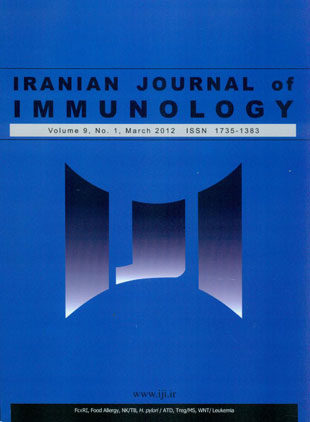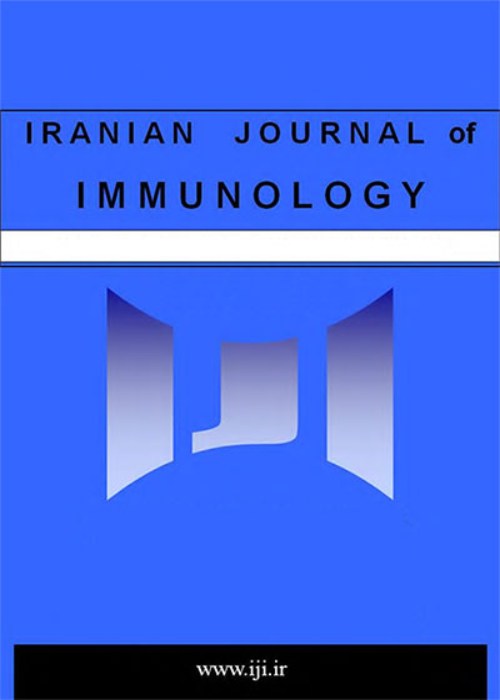فهرست مطالب

Iranian journal of immunology
Volume:9 Issue: 1, Winter 2012
- 76 صفحه،
- تاریخ انتشار: 1391/03/10
- تعداد عناوین: 7
-
-
Pages 1-13BackgroundSecretory proteins of IgE receptor activated mast cells and basophils play apivotal role in the generation of immediate and long term immune responses in allergy and type I hypersensitivity.ObjectiveThe present study aims to generate a 2-D map and profile of proteins secreted from a high secretory variant of the rat basophilic leukemia cell line,RBL-2H3.1, which in view of the difficulty associated with gaining adequate numbers of pure primary mast cell and basophiles, represents an accepted model system for the study and standardization of the methodology to characterize the secretome of these cell types.MethodsA 2-D map of secretory proteins was generated by 2-D PAGE and a shotgun massspectrometric approach carried out for protein identification.ResultsStudy resulted into identification of 299 proteins released from resting and IgE receptor activated RBL-2H3.1 cells after 90 s, 30 min and 3 h antigen challenge. Further sequence analysis identified ~53% of total proteins as secretory proteins which could be attributed to classical and non-classical secretory pathways. Additionally, functional classification of classic secretory proteins verified the presence of proteins belonged to cytokines, receptors, membrane proteins,lysosomal proteins and proteins associated with specific sub-cellular localizations such as endoplasmic reticulum, mitochondria, nucleus, cytoplasm and ribosome. According to this data the presence of some secretory proteins such as cytokines (e.g. MCP-2, PF-4, CSF-1 and TGF-β1) are all subject to Ag challenge which may point to their importance toward pathogenesis in allergic diseases.ConclusionIn view of both a beneficial and adverse role of mast cell mediators in health and disease, an identification of temporal changes in the secretory pattern may form the basis for future tailor made intervention strategies that may enable us to harvest the therapeutic potential inherent in mast cell exocytosis while inhibiting/attenuating negative outcomes.
-
Pages 32-38Bakground: Atopic dermatitis is a major public health problem, often starting in early childhood and sometimes followed by other allergic diseases. Although hypersensitivity to foods is assumed to play an essential role in the development of atopic dermatitis in some patients, little is known about common food allergens in Iranian children with atopic dermatitis.ObjectivesThis study was designed to identify probable food allergens in Iranian children with atopic dermatitis and find the relationship between food sensitization and the severity of atopic dermatitis.MethodsThis study included 90 children aged 2-48 months with atopic dermatitis. Skin prick tests for cow’s milk, hen’s egg, almond, potato and soybeanwere done. Serum specific IgE to 20 food allergens was also screened.ResultsAmong children with atopic dermatitis, the frequency of food sensitization was 40% by skin prick test and 51% by food-specific IgE. Children with atopic dermatitis were most commonly sensitized to cow’s milk (31%), hen’s egg (17.7%), tree nuts (17.7%), wheat (12.2%), potato (11.1%), tomato (8.8%) and peanut (8.8%). In 42 children with moderate to severe eczema, sensitivity to food allergens was 78.5% by skin prick test and 88% by serum specific IgE evaluation.ConclusionOur results showed that cow’s milk, hen’s egg and tree nuts were the most common food allergens in Iranian children with atopic dermatitis. Sensitization to foods was much higher in patients with moderate to severe atopic dermatitis. Determining specific IgE in children with atopic dermatitis can be helpful in managing these patients.
-
Pages 39-47BackgroundNatural killer (NK) cells are the effector cells of innate immunity that respondto infection and tumor. Interactions between killer cell immunoglobulin like receptors (KIR) and human leukocyte antigen (HLA) class I molecules regulate NK cells responses to eliminate infected and transformed cells.ObjectiveTo investigate the impact of KIR genes,HLA ligand genes, and KIR-HLA combinations on susceptibility to tuberculosis (TB) in Lur population of Iran.MethodsThe genomic DNA of 50 patients with TB from Lorestan province of Iran was genotyped for sixteen KIR genes and their five major HLA class I ligands were determined by a polymerase chain reaction-sequence-specific primers (PCRSSP) assay. The results were compared with those of 200 healthy unrelated Iranian individuals.ResultsIn Lur population of Iran, a significant decrease in frequency of KIR3DS1 was found in TB patients compared to control group (24% vs. 44.5%, OR=0.394,CI=0.194-0.798, p=0.013). Also, among the three activating genes that may use HLA class I molecules as their ligands, a significant decrease was shown in frequency of KIR3DS1 with HLA-B Bw4Ile80 ligand in TB patients compared to control group (4% vs. 23%, OR=0.14,CI=0.033-0.596, p=0.004).ConclusionThese findings imply a genetic imbalance between activating and inhibitory KIR genes and KIR-HLA combinations in Lur TB patients. Low level of activating KIR3DS1 and its combination with HLA-B Bw4Ile80 ligand might have aninfluence on the susceptibility to TB in Lur population of Iran.
-
Pages 48-52BackgroundInfectious agents have been suspected as a triggering factor for development ofautoimmune thyroid disease (ATD). Some reports from Western countries have suggested association between Helicobacter pylori (HP) infection and ATD.ObjectiveTo investigate the association of ATD with Cag A seropositivity in a population with high rate and early age of onset of HP infection.MethodsIgG anti HP and anti Cag A antibodies were measured in 88 patients with ATD and compared with results of 112 healthy individuals.ResultsThe rate of infection with HP was not significantly different in patient and control groups, but there was significant association between ATD and infection with Cag A strains (p<0.005).This association was significant for both hypothyroidism (p<0.005) and Grave's disease (p<0.02). Cag A antibody level correlated with titers of thyroid auto antibodies (p<0.001).ConclusionIn a population with high rate and early age of onset of HP infection, only infection with Cag A positive strains is associated with ATD, and this may be due to immune cross reactivity.
-
Pages 53-60BackgroundAtherosclerosis is a multifactorial disorder with chronic inflammatory conditions in which immune cells play a significant role in its pathogenic process. Regulatory T cells (Treg), as a part of immune system, are involved in controlling autoimmune and inflammatory diseases. Quantitative and/or functional alteration of Tregs has been shown to play an atheroprotective role and may also promote plaque stabilization.ObjectiveTo assess if inducible costimulatory molecule (ICOS) expression on one subtype of Treg cells with high suppressive potential correlates with the pathogenesis of atherosclerosis.MethodsPatients with myocardial infarction (MI) and/or stable angina (SA), diagnosed asatherosclerosis by angiography, and a group of individuals with normal coronary angiography(NCA) were recruited for the present study. Peripheral blood mononuclear cells (PBMCs)were prepared and the expression of ICOS, Foxp3 and CD4 molecules was tested by flowcytometry.ResultsThe percentage of CD4+Foxp3+ Treg cells was reduced in MI group compared to NCA and SA groups (p<0.005). Evaluation of the two Treg subsets according to ICOS expression showed a decreased ICOS+/ICOS- Treg ratio in MI and SA groups compared to NCA individuals (p=0.002 and p=0.048, respectivly).ConclusionThe present data indicate that Tregs and its ICOS+ subsets are decreased in patients with MI or SA,suggesting a potential role for Treg in atherosclerosis progression or onset of acute coronary syndrome.
-
Pages 61-71BackgroundDysregulation of WNT signaling has been reported in many malignancies.ObjectiveThis study was conducted to investigate the expression pattern of 14 members of the WNT gene family in different immunophenotypic subtypes of ALL.MethodsSemiquantitative RT-PCR was performed on samples from 71 ALL patients and 36 age-matched healthy individuals. The ALL patients were categorized into B-ALL (76%), T-ALL (22.6%)and mixed lineage (1.4%) and the B-ALL cases were further classified into pro-B, pre-BI, pre-BII and immature/mature-B based on immunophenotypic results.ResultsAmong the WNT genes, WNT-7B (p=0.026), WNT-9A (p=0.020) and WNT-16B (p=0.023) were significantly over-expressed, whereas WNT-2B (p=0.033), WNT-5A (p=0.016), WNT-7A (p<0.0001) and WNT-10A (p<0.0001) were down-regulated in B-ALL. Among the T-ALL subtype, however, significant down-regulation of WNT-2B, WNT-5B, WNT-7A, WNT-10A and WNT-11 was evident. Comparison between B-ALL subtypes showed significant overexpression of WNT-7B, WNT-9A and WNT-B in certain subtypes.ConclusionOur results suggest contribution of the WNT genes in leukemogenesis of ALL.


